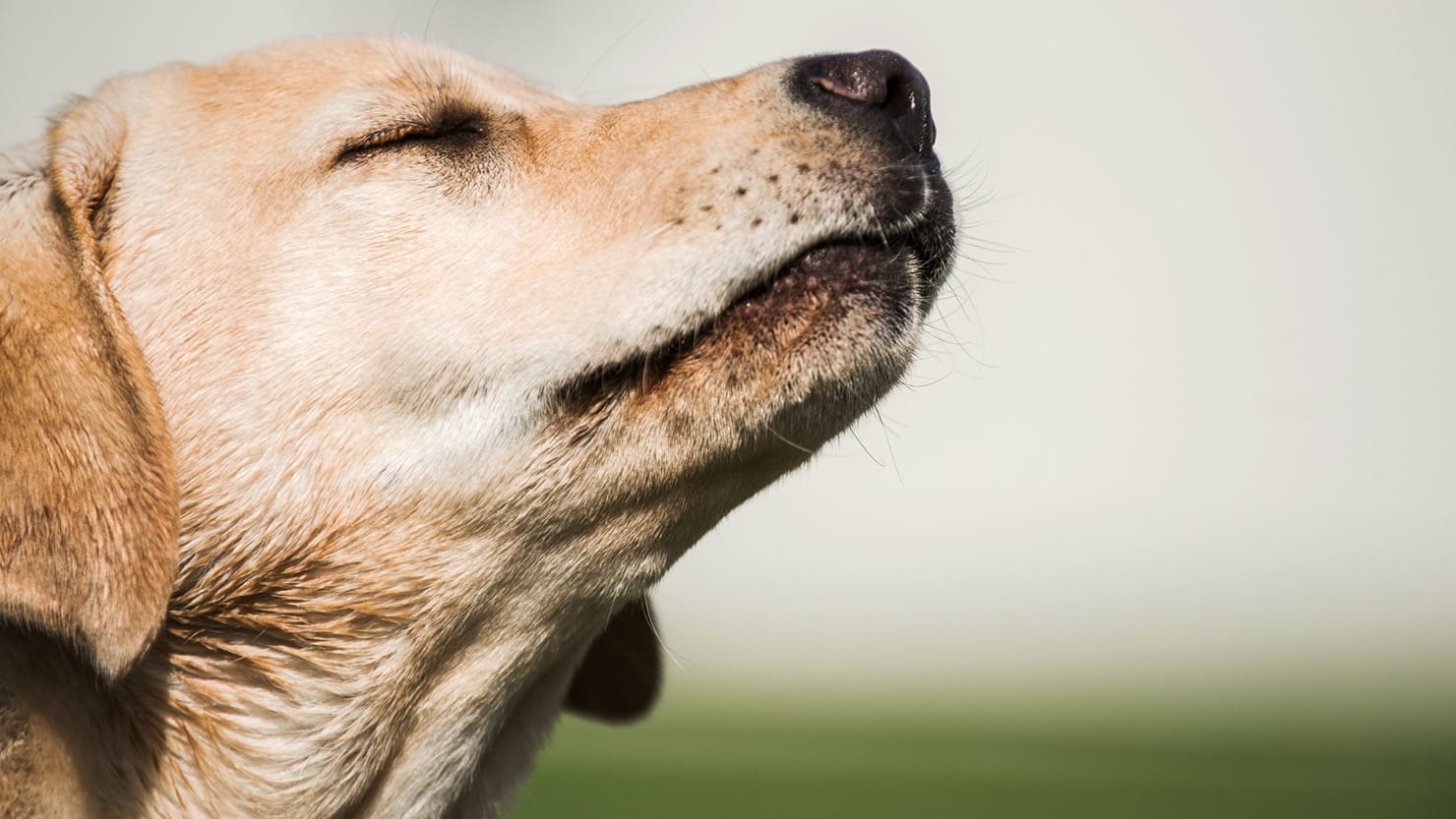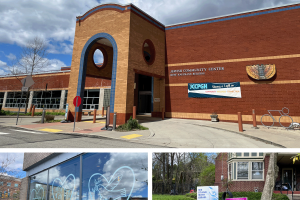For several days in October 2021, employees at the monthly dog toy subscription service provider BARK had to get past three bouncers to enter their offices. But Noel, Buddy, and Solo had little in common with the rest of New York’s typical nightclub bouncers; rather, the three were beagles trained to sniff out active COVID-19 infections in people returning to the office.
The pups sniffed each employee who walked through the door and were trained to sit if they detected an infection. Any employee who “tested” positive would be asked to leave the office, confirm the sniff test with a PCR or rapid antigen test, and then isolate if the actual medical test came back positive as well.
“We wanted to invite our colleagues to come back in a setting where they could be the most comfortable, and the COVID-sniffing dogs were the perfect partners to make that happen,” Dana Rosenkranz, BARK’s senior manager of real estate and workplace, told The Daily Beast in an email. “Our employees found this extra precaution comforting.”
The three pooches were trained and deployed by BioScent Detection Dogs, a Florida-based company specializing in training predominantly beagles to detect COVID-19 infection. According to the website, 64 dogs are currently in training to detect COVID-19 at events locations including concerts, construction sites, and workplaces.
On the heels of the pandemic’s own spread, COVID-19 detection dogs have swept the nation. They’ve been put to work in schools, among the entourages of famous musicians, and even at Miami International Airport. And the appeal is easy to see.
“We loved having the dogs in the office—they are much more adorable than a COVID test,” Rosenkranz said. “They’re also incredibly fast and efficient.” Studies have found trained dogs’ sniff tests to be over 90 percent accurate at detecting COVID-19.
But in a pandemic that has hit the U.S. in waves, the market for COVID-19 detection dogs is now plateauing. Dogs’ training and motivation to work often continues into their “retirement,” even when the demand for their services is lukewarm at best. Combined with a similar boom and bust cycle for marijuana detection dogs, the story of COVID-19 detection dogs raises questions about the downsides of treating live animals like a diagnostic technology.
The Science Behind the Snoots
What, precisely, dogs are picking up on when they smell a COVID-19 infection is still somewhat of a mystery to us. Compared to dogs’ noses, human schnozzes are woefully inept at distinguishing farts from flowers. Dogs, on the other hand, have specialized snoots for inhaling scents and more receptors inside their noses for latching onto and categorizing airborne smells technically known as volatile organic compounds. It’s distinct mixtures of these volatile compounds that give humans an olfactory fingerprint—and that change when a person has a respiratory infection like COVID-19.
But super smell alone cannot explain how beagles and other breeds can detect COVID-19 with comparable accuracy to a PCR test. The next step is training these dogs: a process that is in some ways similar to training a machine learning algorithm.
Typically, a programmer will give a machine learning model a training data set that it can use to identify patterns and inform future predictions. Imagine an algorithm that looks at pictures of the sky to predict sun or rain—a training set could consist of pictures defined as one type of weather or the other, so the model can “learn” to associate certain details like storm clouds and clear skies with rain and sun, respectively. The beauty of machine learning algorithms is that they can identify patterns and details in data-rich samples that humans may not otherwise notice (in the hypothetical, perhaps the color of the sky or some other minute detail).
The same goes for scent detection dogs. Heather Junquiera, the founder of BioScent Detection Dogs, spent years training dogs to pick up on scent patterns even before the COVID-19 pandemic. Her training process for puppies takes about six months, starting with getting them accustomed to detecting a scent inside a canister and getting them used to “indicating”—the term trainers use for when a dog responds a certain way to show they have detected a positive scent. Most sniffing dogs indicate by sitting.
Whenever the dog signals in front of the correct canister, they are positively rewarded with a treat; once the pup has mastered this process, Junquiera will train them on the breath condensate of a COVID-19 patient.
“Dogs’ training and motivation to work often continues into their “retirement,” even when the demand for their services is lukewarm at best.”
Once they’ve honed in on identifying positive scents, the dogs can go out into the real world and sniff people, recognizing the patterns in volatile organic compounds they had spent the past months sniffing in training. Like with some machine learning algorithms, humans have a hard trouble determining what differences the dogs are discerning between COVID-positive and negative patients—we just know it works.
Junquiera decided to pivot to COVID detection in April 2020 when an ER doctor from Florida reached out to her asking if she could train dogs to detect a new disease. “There’s this virus that we think is going to cause a problem,” she recalled him saying.
She responded by saying she thought she might be able to help, but wasn’t 100 percent sure. After looking through published literature on dog sniffing as a detection tool for disease and partnering with researchers to study groups of dogs she trained, she felt more confident that she could train dogs to sniff out COVID.
Other peer-reviewed research has backed her up since. One study published in May in BMJ Global Health found that four dogs trained to detect COVID-19 from skin swabs did so with over 90 percent accuracy on over 400 samples, compared to PCR tests. Independent studies largely support this level of accuracy. There’s also preliminary research suggesting that dogs can train on samples from long COVID patients and distinguish their scent from healthy individuals.
Even with the science on her side, Junqueira said that business has been slower as of late. As COVID restrictions have been lifted and U.S. businesses and large events have become more lax about positive cases, there’s less of a demand for detection dogs.
“During the pandemic when everything was at its peak, we were obviously a lot busier,” she said. “In my kennels, I have a much smaller group of dogs that are trained on COVID than before.”
A Canine Unemployment Crisis
It’s not just COVID. Based on the same principles of scent training and detection, dogs have been used to sniff out cancer, neurodegenerative diseases like Parkinson’s, and even semen to help investigate sex crime scenes. Though numbers are difficult to pin down, it seems drugs and explosives are what most detection dogs in K-9 units are trained to recognize. One estimate over a decade ago put the number of active police work dogs in the U.S. at about 50,000—that number has likely risen since, and excludes dogs trained by private companies like BioScent Detection Dogs.
But major changes to drug legislation and policing in recent years have forced entire states’ dog detection units into an early retirement. According to reporting from the Associated Press, doggie layoffs hit the state of Virginia hard last year, when the state legalized possession of marijuana. Thirteen K-9s that worked for the state police were affected by the layoffs, as well as smaller one and two-dog units statewide. It can cost departments up to $15,000 to purchase and train a new dog, so smaller K-9 programs have shuttered outright, according to the AP. Even though K-9 units are often trained to detect and indicate on scents of multiple kinds of drugs and explosives, cross-indicating could put human handlers in a sticky legal situation.
“If there is doubt as to whether a pup indicated on an illegal drug or a now-legal one like weed, a subsequent police search could be deemed unlawful.”
A dog will alert the same way regardless of what substance it is detecting, meaning that if there is doubt as to whether a pup indicated on an illegal drug or a now-legal one like weed, a subsequent police search could be deemed unlawful.
Cross-indication is why Junqueira said that she’s not likely to train a COVID detection dog on a new scent, even if there’s more demand for it.
“You wouldn’t want to train a new odor on [these dogs] because they might indicate on someone for COVID—but if you train them on explosives, that could be a big mistake,” she said.
The pups from BioScent Detection Dogs that are still gainfully employed typically serve two types of clients, Junqueira said. Short-term clients seek to form “bubbles” around themselves, whether in the case of the entourage of pop star Justin Bieber, or a construction crew for a sporting venue in Atlanta. And people who are immunocompromised have gotten in touch with her about adopting unemployed dogs to use in their personal lives, which can offer them a sense of security as they navigate a society that is not as COVID cautious as they are.
Junqueira’s dogs that do not continue in service go into retirement and are adopted out as household pets or live with her. Still, there are unexpected challenges with retiring any form of working dog—whether a service dog or detection dog. Working dogs often find enjoyment and a sense of purpose and enrichment through their trained tasks, and quitting cold turkey may not be best for them. Though retirement has been well-studied in humans, according to a 2019 review paper published in Frontiers in Veterinary Science, “little research has specifically addressed issues regarding the retirement of assistance animals.”
“Retirement can, in fact, be distressing for some animal retirees because the transition from working full time to not working at all can be a dramatic and challenging adjustment,” the authors wrote in the review.
Junqueira said that many of her retired detection dogs come from shelter backgrounds and are more than happy to wind up as professional couch potatoes—but she does suggest that owners provide enrichment for the pups whenever possible.
“We will continue to work on viruses, because unfortunately, I don’t think this is the last of the viruses that we’ll have to deal with.”
— Heather Junquiera, BioScent Detection Dogs
“I encourage that people take them to Loews, take them to Home Depot, take them to PetSmart, whatever dog-friendly place, because that serves that desire,” she said. “They will still indicate most of the time if they smell someone with COVID even though they’re not technically working, because in their mind, they’re always kind of working.”
In these public settings, it’s not always clear what an owner should do when their off-the-clock detection dog indicates on a person. It’s happened to Junqueira several times, and she hasn’t told the (likely COVID-positive) stranger why her dog was indicating in case they might not be receptive to the information or see it as an intrusion.
In those situations, “you just move away because there’s not really guidelines in place for that,” she said.
All three of the pups that visited BARK’s New York office are still working today—two on COVID-19 detection, while Solo, who was a puppy at the time, has now been staffed on a research project that uses detection dogs to identify traumatic brain injuries. So far, he and the other pups have demonstrated high accuracy at identifying brain injury in pigs when trained on breath condensate samples.
Though the market for COVID-sniffing dogs is waning, Junqueira said that she does not see herself fully scaling back the COVID-19 detection program, instead transitioning to work on future illnesses.
“We will continue to work on viruses, because unfortunately, I don’t think this is the last of the viruses that we’ll have to deal with.”






